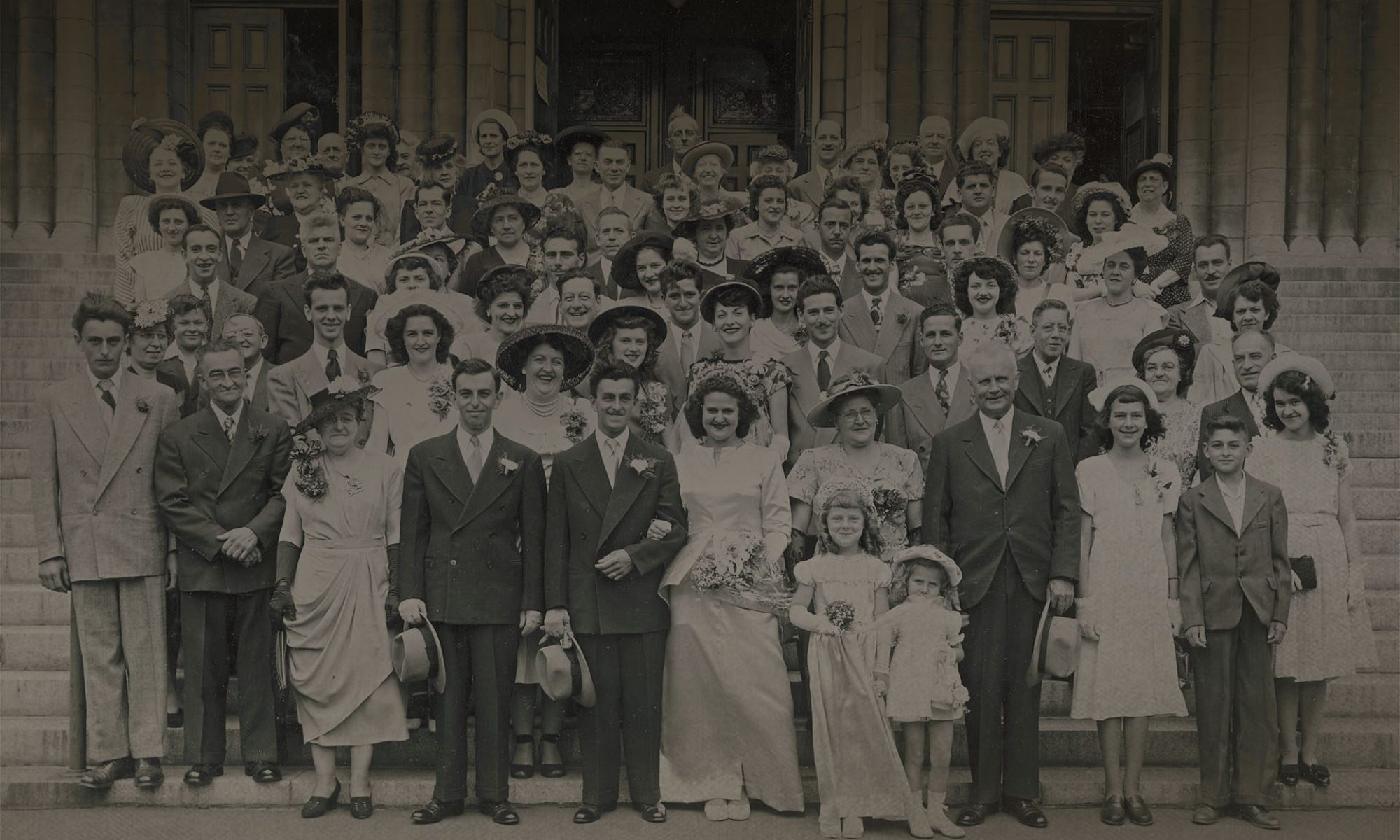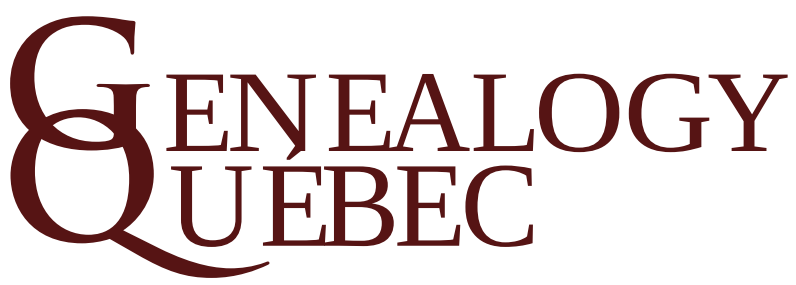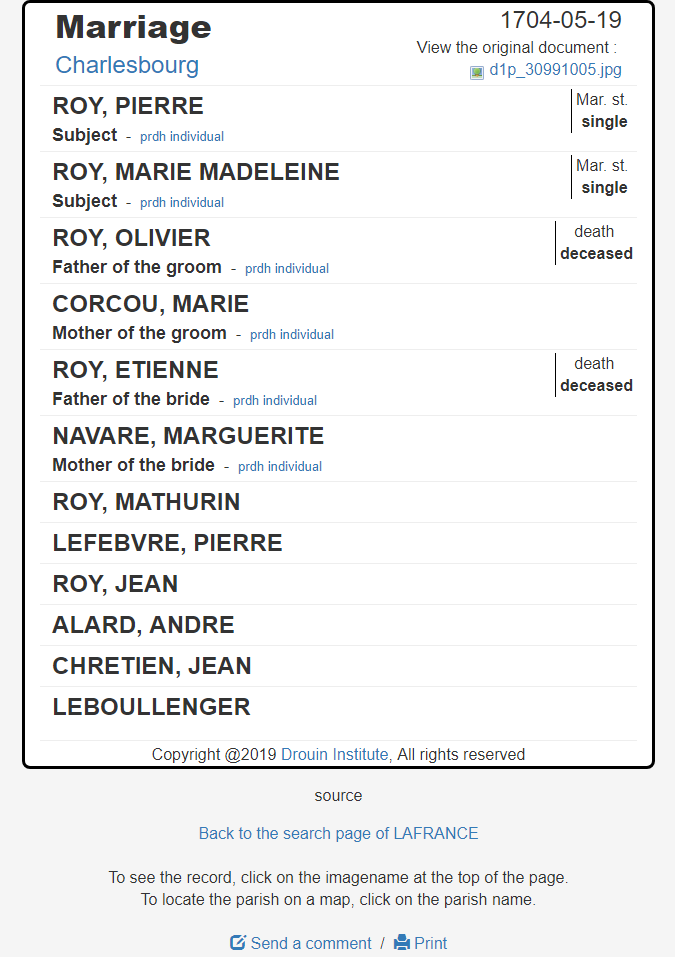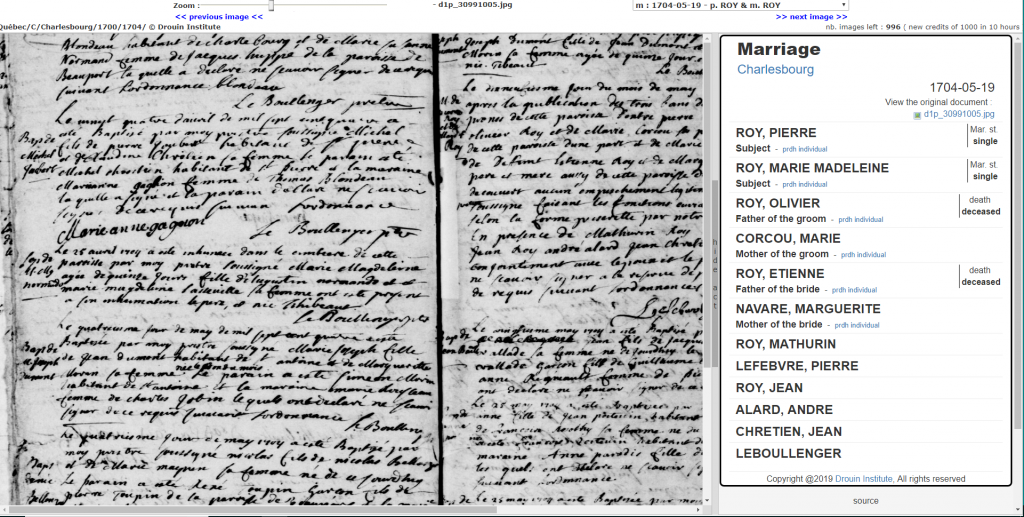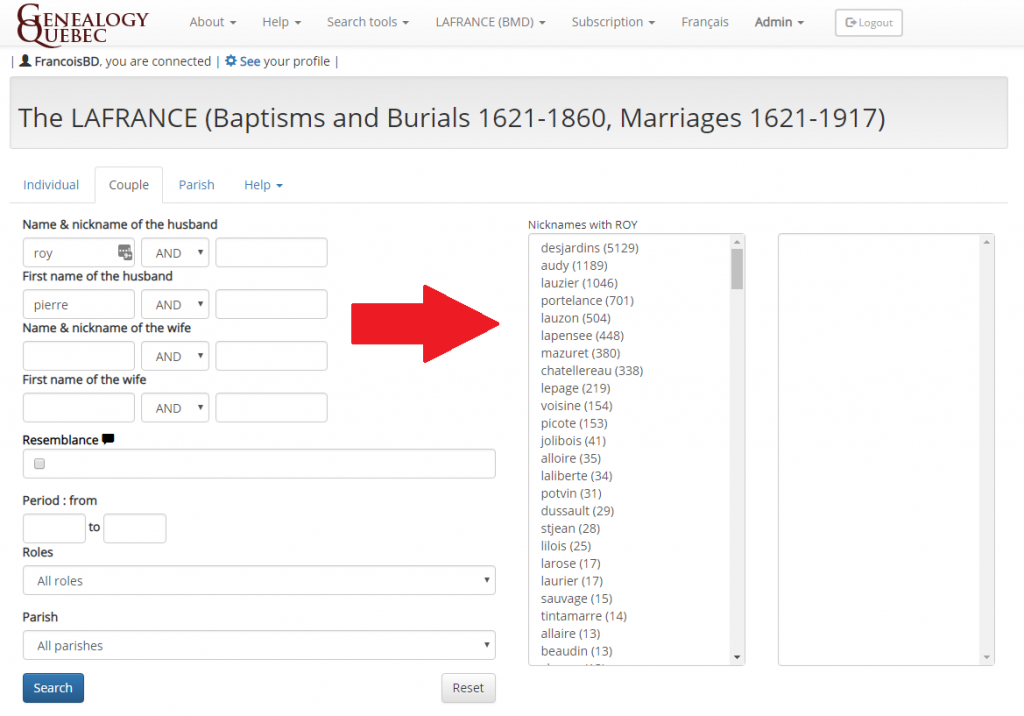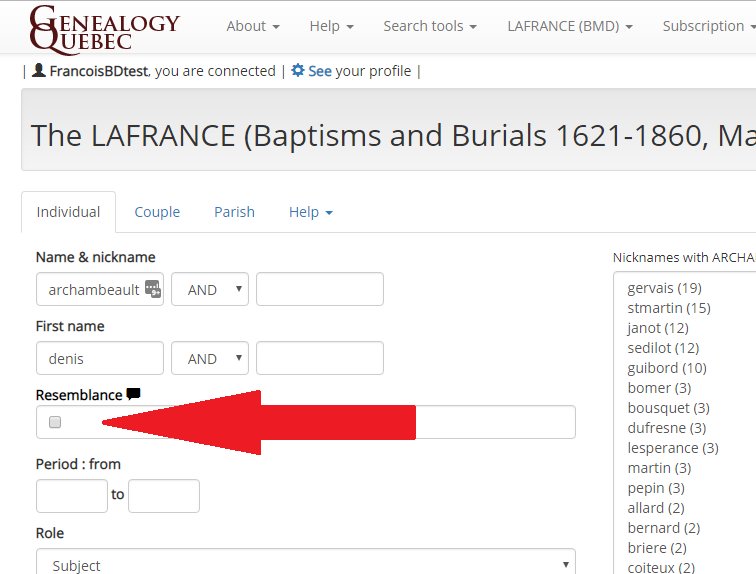This post is also available in: Français
⚠️ Note: This guide pertains to one of Genealogy Quebec’s legacy tools, which are no longer updated. Their content is now integrated into the new unified search engine.
The LAFRANCE is one of 14 tools available to Genealogy Quebec subscribers.
The LAFRANCE will be your most powerful tool for tracing your ancestors on Genealogy Quebec, as it contains over 10,940,000 birth, marriage and death records from Quebec, Ontario, Acadia and the United States. The records are broken down as follows:
- Every Catholic marriage from Quebec between 1621 and 1918
- Every Protestant marriage from Quebec between 1760 and 1849
- Every marriage recorded by the Quebec government between 1926 and 1997
- Every Catholic baptism and burial from Quebec between 1621 and 1861
- Every death recorded by the Quebec government between 1926 and 1997
- 1.7 million additional marriages from various sources in Quebec, Ontario, and the USA between 1919 and today
- Tens of thousands of additional records from Quebec, Ontario and Acadia
You will find these parish records under two formats on the LAFRANCE:
Original documents – a digitized image of the original parish register, as it was originally drafted.
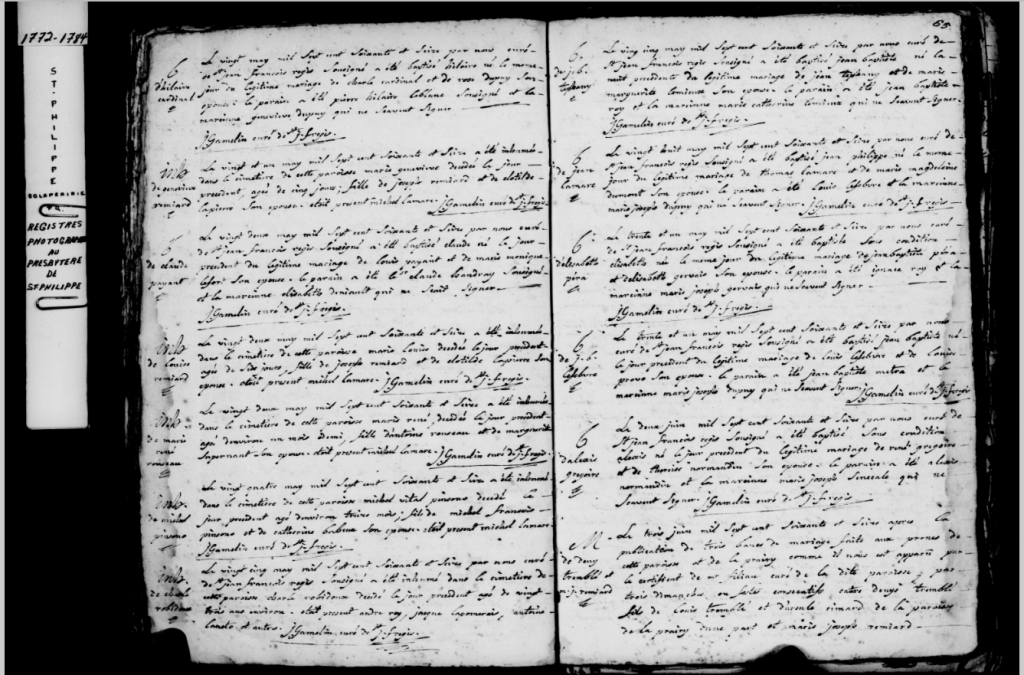
Record certificate – Every record in the database is indexed under what we refer to as a certificate. The certificate contains all the relevant information extracted from the original record such as the names, dates, roles, occupations, relationships, marital status, etc.
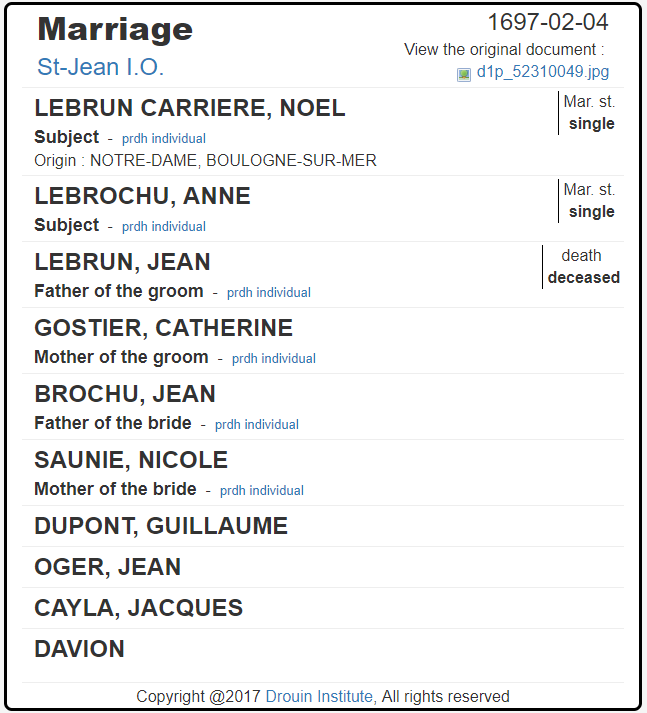
Using the LAFRANCE
The LAFRANCE is divided into 3 research sections: Individual, Couple and Parish. These sections allow you to search for an individual, a couple or for events recorded in a specific parish, respectively.
Individual
The Individual search engine allows you to search for all the mentions of an individual in the records available in the LAFRANCE.
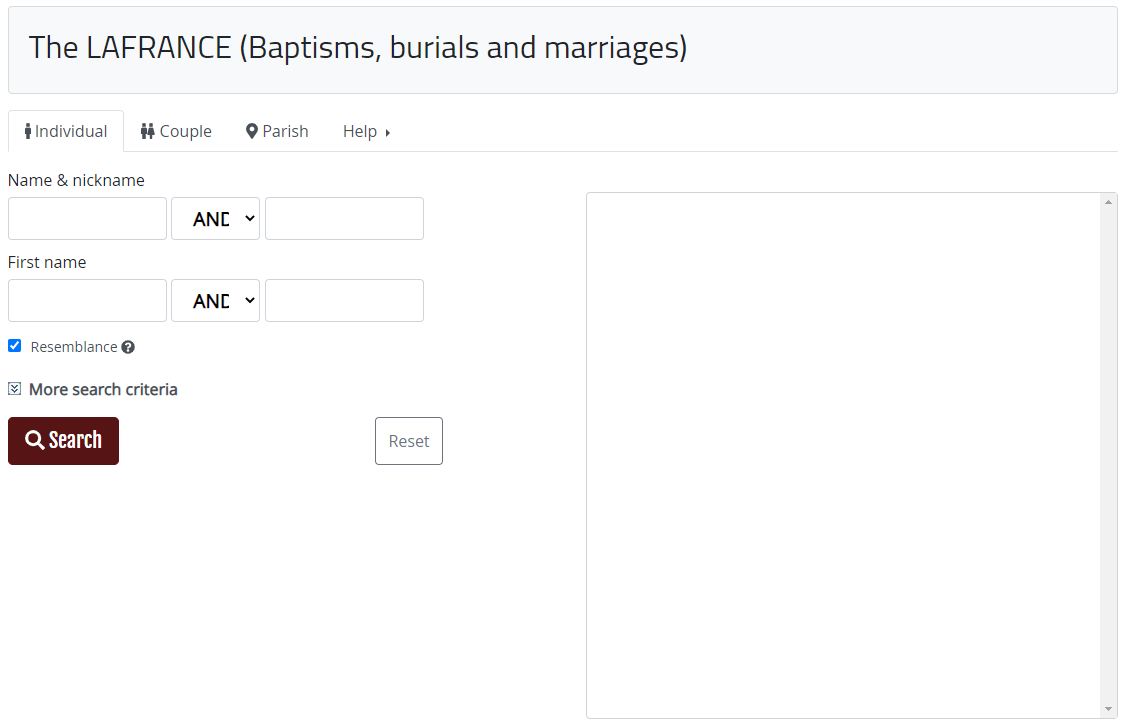
- Name and nickname – Last name(s) of the person sought
- First name – First name of the person sought
- Resemblance – Allows for more variability in names and as such a broader search, more in depth explanation later in this article
- Period – Date range in which the search is performed. Leave blank to include all the years covered by the database.
- Role – Role of the subject in the record (Subject of the record, spouse of the subject of the record, father of the subject of the record, mother of the subject of the record)
- Type – Baptism, marriage or burial
- Sex – Male, Female or indeterminate
- Parish – Limit search to a specific parish
Couple
The Couple search engine allows you to search for all the mentions of a couple in the records of the LAFRANCE. A couple may be the subject of a marriage, or the parents of the subject(s) in a baptism, marriage or burial. A couple may also be the subject of a burial and their spouse.
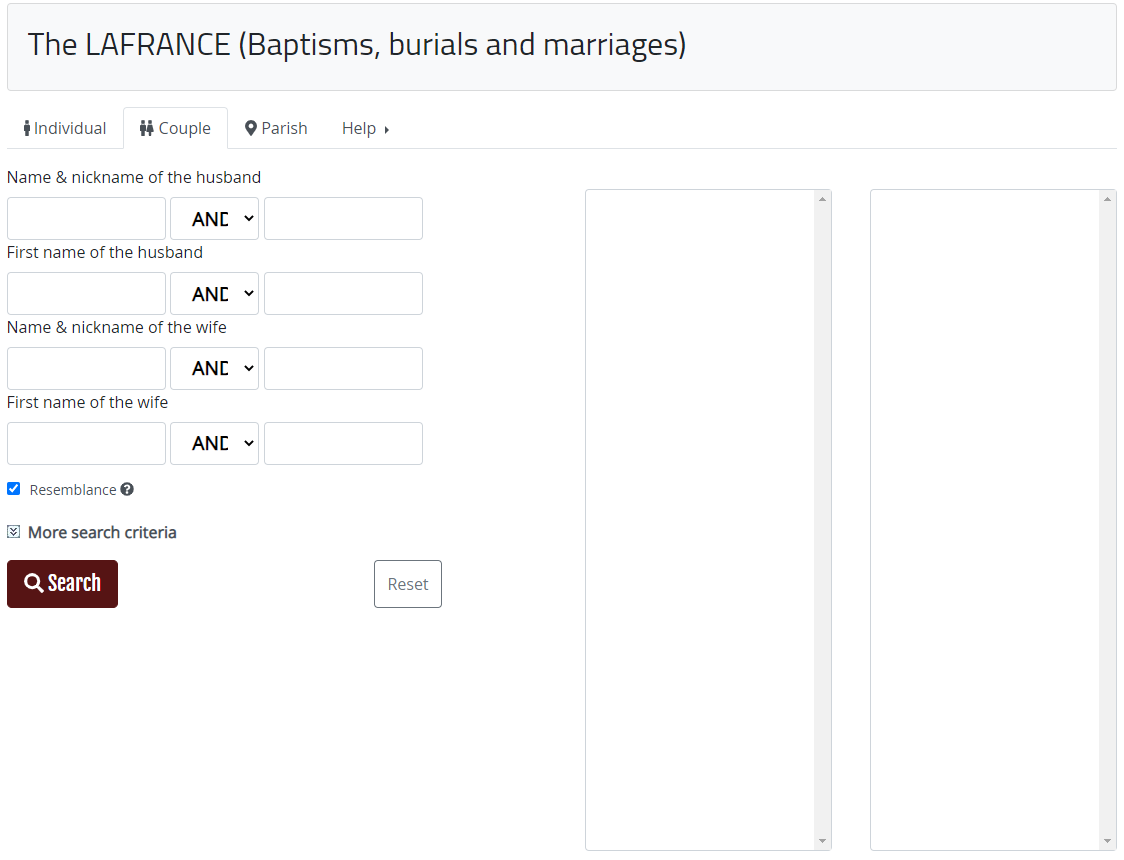
- Name and nickname of the husband – Last name(s) of the husband
- First name of the husband – First name of the husband
- Name and nickname of the wife – Last name(s) of the wife
- First name of the wife – First name of the wife
- Resemblance – Allows for more variability in names and as such a broader search, more in depth explanation later in this article
- Period – Date range in which the search is performed. Leave blank to include all the years covered by the database.
- Roles – Roles of the couple in the record: Subject-Subject (marriage), Father-Mother (marriage, baptism, burial) and Subject-Spouse (burial)
- Parish – Limit search to a specific parish
Parish
The Parish search engine allows you to search for all the records of a specific parish. You can limit this search to a specific date range and type of record (baptism, marriage or burial).
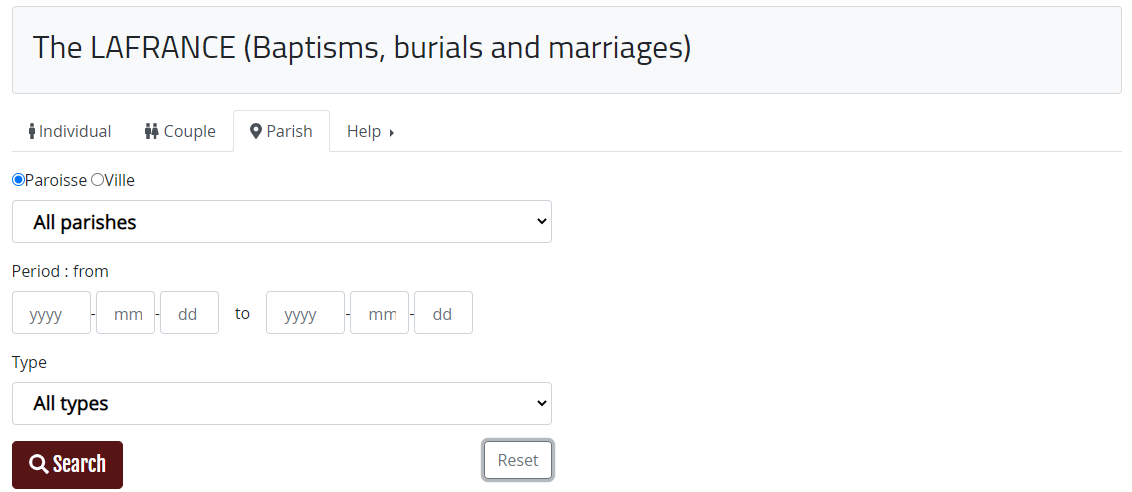
- Parish – Select the parish to search in
- Period – Date range in which the search is performed. Leave blank to include all the years covered by the database.
- Type – Baptism, marriage or burial
Search results
To begin a search, simply fill in the field(s) of your choice and press Search. You will then reach a list of results based on your search criteria.
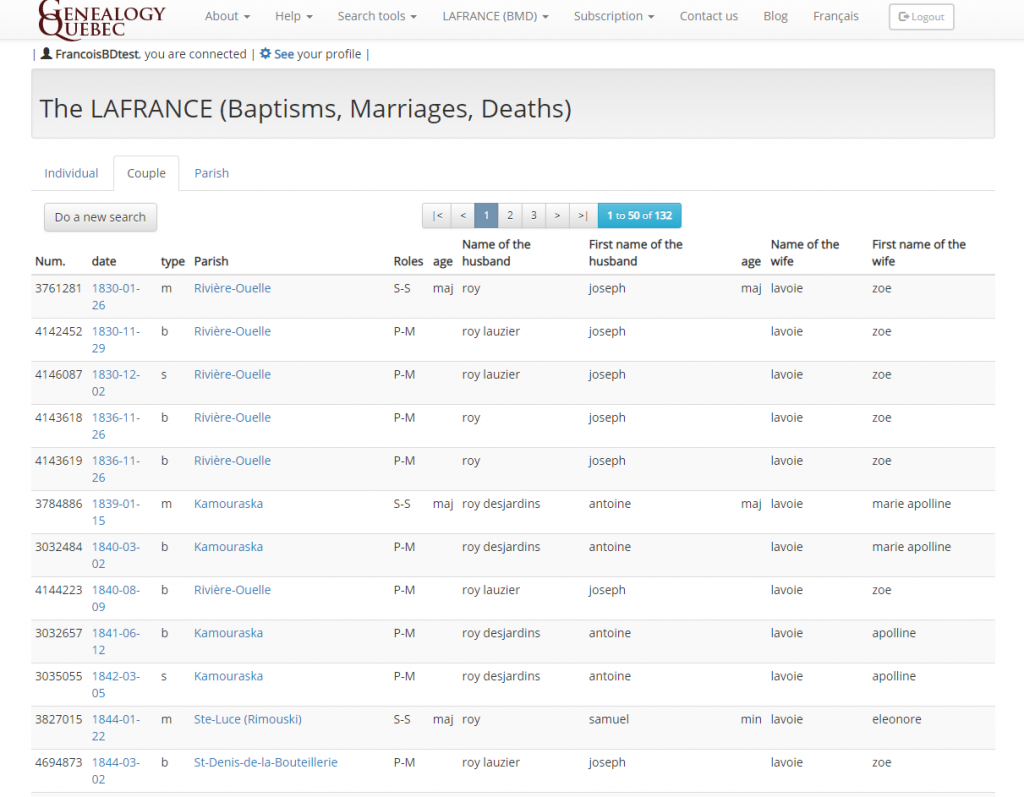
- Num.: Every record in the database is given a number that is used to identify it.
- Date: Date on which the record was drafted
- Type: The type of event described by the record: b (baptism), s (burial) or m (marriage)
- Parish: Parish in which the event was recorded
- Roles: The role carried by the searched individual(s) in the record: P-M (Father and Mother), S-C (Subject and Spouse), S-S (Subject and Subject, used to identify a marrying couple)
- Age: Age of the subject(s), maj for major, min for minor
- Names: Standardized version of the searched name(s), more about name standardization later in this guide
Clicking on the name of the parish will take you to the location of this parish on our interactive map of Quebec based Catholic parishes.
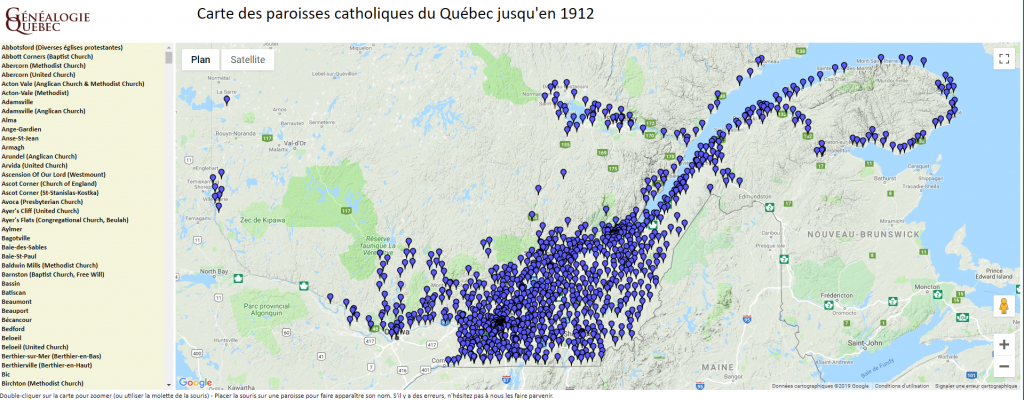
To view the record certificate, click on the date associated to that record in the list of results.
The record certificate contains all the relevant information extracted from the original document. You will find the names of the subject(s) and the parents, the role and the relationship between each individual mentioned in the record, the date on which the record was drafted as well as the date of the event, the marital status of the subject(s), the age of the subject(s), and more.
To view the original document itself, click on the image link found under the date of the event.
“Dit” names
If you’ve done genealogical research in Quebec in the past, it is likely that you’ve encountered “dit” names before. A “dit” name was used to differentiate individuals with similar family names in the same region. In the context of genealogical research, “dit” names can be viewed as a second surname given to an individual.
For example, a common “dit” name combination is Roy dit Desjardins. If you descend from the Roy dit Desjardins line, your ancestors will have gone under Desjardins, Roy, as well as Roy dit Desjardins over the generations. This can be a bit confusing if you’re not aware of it, as you may wonder why your ancestors would suddenly switch between two surnames.
This is why the LAFRANCE includes a Nickname tool, which gives you a list of “dit” surnames commonly associated with the last name you are researching.
When you enter a surname in the search field, a list of “dit” names commonly associated to that surname will appear in the box to the right, ordered by frequency.
This tool is very useful because it can allow you to trace a line that has gone under different family names over the generations. For example, if you are unable to find the marriage of the parents of your ancestor Pierre Desjardins, you will be aware of the possibility that the father of Pierre Desjardins bore the name Roy on his marriage, allowing you to find the record in question.
You can learn more about French-Canadian “dit names” and nicknames in this article on our blog.
Name standardization
The LAFRANCE search engine is equipped with a name dictionary, which associates a name with all of its variations. For example, a query for an individual with the surname Gauthier will prompt the search engine to look through the database for any mention of the name Gauthier as well as any of its variations, such as Gautier, Gaulthier, Gotier, etc. Thus, it isn’t necessary to manually search for multiple variations of a name.
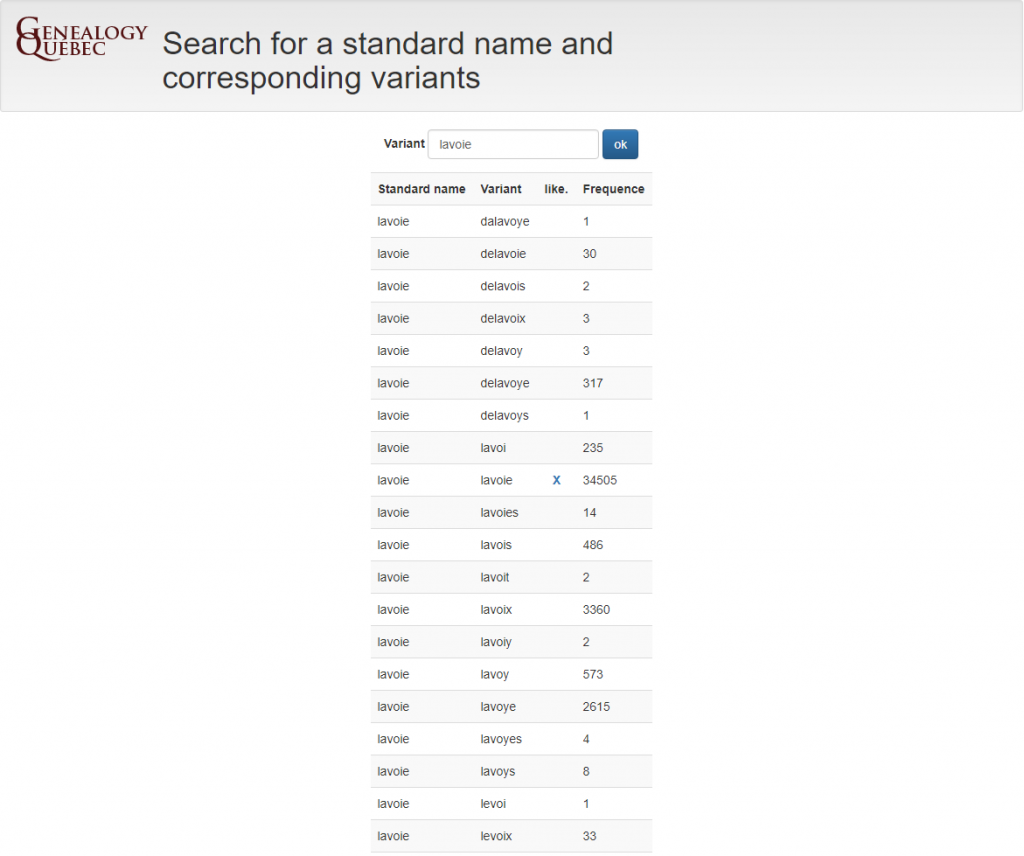
You may browse the LAFRANCE name dictionary at this address.
Please note that when searching on the LAFRANCE, the result list will always show the standard spelling of the name(s) you searched. However, the record certificate will give you the specific spelling used in the original record.
The resemblance/likeness function
The resemblance function, otherwise known as the likeness function, makes it possible to search for a name as well as any other name that resembles it. The resemblance function differs from name standardization because it not only includes all of the variations of a name, but also all of the names that are similar to it in terms of pronunciation or spelling. For example, a search for Gauthier, which will include all of the variations given earlier, will also include the names Gonthier, Vauthier, Gouthier, Authier as well as their numerous variations.
You can activate the resemblance function by checking the resemblance box on the LAFRANCE search page.
We recommend that you keep the resemblance function turned on at all times.
Search tips
The LAFRANCE’s search engine allows searching for many variables, which makes it tempting to fill as many fields as possible when using the tool. However, we recommend that you keep your initial search as vague as possible, and clarify it as needed by adding one piece of information at a time. When the name or surname searched is rare or unusual, it is rarely necessary to add more information to the search.
The more precise a search is, the more likely it is to omit the record you are looking for, as every single field must match.
For example, an initial search could start with the surname and first name of the subject. If the number of results is too high, a variable such as the year of the event or the surname of another individual mentioned in the record can be added. Often, simply adding a third variable is enough to narrow the search down sufficiently.
We also recommend, if necessary, to try several combinations of names when looking for a record. For example, imagine that we are looking for the marriage of Louis Lamontagne and Cécile Dubé. It is possible, for various reasons, for one of the spouse to have gone under a partially different name on their marriage record. If searching for “Lamontagne” as the name of the husband and “Dubé” as the name of the wife does not allow us to find this marriage, it may be interesting to try other combinations:
- First name of the husband: Louis
- Last name of the husband: empty
- First name of the wife: empty
- Last name of the wife: Dubé
OR - First name of the husband: empty
- Last name of the husband: Lamontagne
- First name of the wife: Cécile
- Last name of the wife: empty
And so on. As a result, if an error exists in one of the first or last names of the subjects, we will still be able to find the record.
Finally, note that you may use the “%” character in order to search for part of a name. For example, a search for “Rog%” will find all of the records where an individual bearing a name that starts with “Rog” is mentioned. This allows you to widen your search even further, if necessary.
Accessing a PRDH-IGD individual file from a LAFRANCE certificate
If you are subscribed to both PRDH-IGD.com and GenealogyQuebec.com, you can view the PRDH-IGD individual file of an individual mentioned in a LAFRANCE certificate with a single click.
To do so, make sure you are logged into both websites, and then click on the “prdh individual” mention found on the LAFRANCE certificate you are viewing.

The individual file centralizes all of the mentions of an individual in the database, such as the person’s baptism, burial and marriage. The individual file also mentions the parents as well as the spouse(s). You can read this article for more information on individual files and the PRDH-IGD.
You can also learn more about the similarities and differences between PRDH-IGD.com and GenealogyQuebec.com on this page.
Useful links
The LAFRANCE (subscription required)
First name standardization
Last name standardization
“Dit” names associations
Quebec Catholic Parish map
Annual frequency of records in a parish
Subscribe to Genealogy Quebec
What is Genealogy Quebec?
Subscribe to PRDH-IGD.com
What is PRDH-IGD.com?
Genealogy Quebec and PRDH-IGD: the similarities, differences, and why you should subscribe to both
